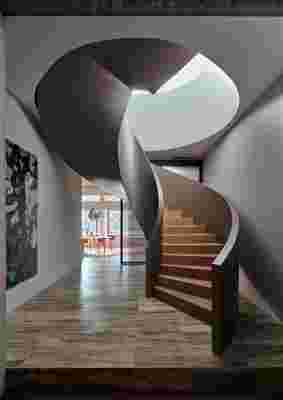When architecture firm Powerhouse Company cofounder Nanne de Ru decided to build a new home for his family some six years ago, he aimed for the sky—literally. “[Our headquarters] was located in an old, abandoned office building, in what is called an empty squat—a way to prevent squatters,” says De Ru, looking back. The building was in terrible condition, constructed in the 1960s, with low ceilings installed in the 1980s and walls seemingly everywhere. After a while, he poked around a bit and discovered that much of the building actually had relatively high spaces, behind dropped ceilings. “And sometimes on Fridays, we would all go up on the roof and have a beer, and there was this amazing view of Rotterdam,” De Ru adds. “That’s when I said to my wife"—who also works at the firm—"that it would be amazing to build our house up there.”

The Powerhouse Company signature spiral staircase connects the top floor of the existing building with the newly created penthouse. The stair is made of champagne-colored stucco and oak steps.
Two years later, following a change of zoning, they ended up with the entire five-story building and began painstakingly carving out 20 individual apartments within, keeping the roof for themselves. (They also used part of the preexisting top floor for their three children.) Ultimately, De Ru designed a sleek and elegant structure that sits on the building, giving deference to its panoramic views of the city, the harbor, and the skyline. “The sun moves around the house all day,” he says of the striking contemporary structure. “The glass sheets [enclosing the house] are quite large—one is slightly curved to give it elegance and not be too boxy. The [apartment’s] roof rests on the glass, the largest example of load bearing glass in Western Europe.”
On the main level, there is a living room, kitchen, dining room, master bedroom suite, and music room. “This room is crucial, as we all play instruments and sing,” De Ru shares enthusiastically. “And they have a shared space on the fifth floor and their own little balcony to play soccer,” De Ru says of their kids. “We have a lot of fun.”


The ultimate resource for design industry professionals, brought to you by the editors of Architectural Digest
Materials are important to the mix, as De Ru wanted to incorporate ones used in post-war Rotterdam, such as travertine, mahogany, and green stone. It was important for him to pay tribute to the building historically, as well as to the reconstruction of the Dutch city itself. Other materials throughout include gold resin on the kitchen doors, adding a warm glow, and a Powerhouse signature staircase of gold, metallic-painted stucco, and oak steps. It’s easy to understand why this house in the sky—always full of family and friends, music, and parties—was, in De Ru and his family’s view, well worth any extra effort.
